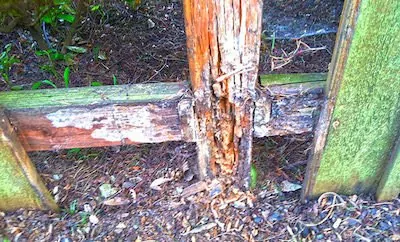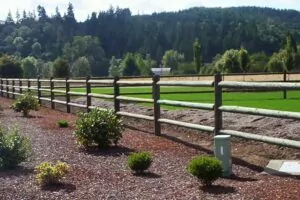A repaired or new fence can add value to your property, add privacy, or add a decorative aspect to your yard, but there’s a few things to know before you jump feet first into a new fence. Here’s your guide to planning for a new fence.
Should I Repair or Replace my Fence?

The first thing to consider is what kind of fence you have. If your fence is vinyl, chain link or decorative metal (wrought iron), you may want to consult with a fence professional so you can get the most accurate information possible. Often times with these types of fences only sections of the actual fence need to be fixed. Chain link fences, which are fairly durable, can be susceptible to rust though if caught early enough can be treated to prevent further damage. Vinyl fence is also very durable but due to its plastic properties it can fall victim to a different array of damage including warping and cracking.
If your fence is built from wood you can usually tell yourself if it needs to be completely replaced or repaired. Start by inspecting the fence boards from the bottom up. In most instances, the boards will begin to rot from the bottom where they usually have contact with the ground. This is especially true here in the Pacific Northwest where we tend to see more rain than the rest of the country. If you cannot visually see if the boards are rotted you can try scraping indiscreet area of the board with a nail or other hard object. If the wood easily disintegrates, it is most likely rotted. If only a few boards are rotting you may simply be able to replace just those boards. If more than a quarter of the boards on your fence are rotted, it is time for a new fence.
Checking the integrity of your wooden fence goes beyond just check the face boards, however. You also need to check if the fence posts are still in tact. This is usually a pretty simple task. First, try and find an angle where you can look down the length of your entire fence line. Are the posts in a straight line or are some of the tilting in different directions? If they are not in a straight line the posts may be rotting. To check if your posts are rotting you can use the same test we used above with a nail or you can simply try and shake the post. If it is pliable it is most likely rotted and it is time for a new fence.
Next Steps in Planning for a New Fence
After you’ve determined whether or not your fence will need to be completely replaced or just repaired in places, there are more decisions that will need to be made.
Decide on the Primary Function for Your Fence
While most fences will ultimately serve more than one purpose, pinpointing your primary purpose will help you make important decisions regarding materials and layout.
For example, maybe the main purpose for the fence is to keep your dog in the yard, and the second purpose is to frame your garden. Recognizing the primary need for containing your dog helps you figure out the necessary height and strength of the fence. After you’ve decided on those essential elements, then you can start thinking about ways the fence can aesthetically complement your garden.
Decide on Desired Access Points

You also need to consider what you will be using the access points for. Will they be just for people passing through? Would you eventually like to fit wider equipment, or even drive a lawnmower or vehicle through? Discovering your answers to these questions will help you decide on the type and necessary width of gates you can install.
You should also decide on the number of access points you want. Our team at Pacific Fence & Wire recommends having at least two. Not only is this practical, but having multiple exit points can also help during emergencies.
Look into the Details of Your Property
Your residence will have buried electrical lines and water connections. Since these are not visible from the surface, you may need to review your blueprints to find them.
Thoroughly reviewing your blueprints is an absolutely essential step, and should be done in the very first stage of planning, so you don’t accidentally design (or build!) a fence on top of an underground feature such as a water or power line.
It is similarly crucial to figure out exactly where your property line falls, particularly if you want your fence to hug the perimeter. (If the blueprints don’t specify where your property line is, here are a few ways you can find out.)
Find Out If There Are Any HOA or Neighborhood Regulations and Talk to Your Neighbors

Certain municipalities will also have regulations regarding home appearance, such as height restrictions for fences. Find these out ahead of time, so you can incorporate them into your design.
Additionally, make sure you talk to the neighbors that your fence may impact. If the fence is on your property, you are within your rights to build the fence but communicating to them about the upcoming change is a nice thing to do. If the fence is on the border or your property and theirs, you may be able to come up with a compromise and maybe even split the cost on the project. Make sure to get any kind of agreement with them in writing. In these cases, it is particularly helpful to be respectful of the neighbor’s own preferences in terms of fence type. You might consider sharing your design ideas with them so they are happy with the final product as well.
Determine Your Budget and Materials

The most economical fences will have standard 90° intersections and be on flat ground. Special angles or accommodating slopes are customizations that will increase the price.
Quality Fencing Services in Portland, OR
If you would like any assistance with planning for, designing, and/or constructing a new fence for your home, Pacific Fence & Wire would be happy to provide a free consultation. From discussing fence materials to the design itself, we are here to lend a hand. Just give us a call and we can help you get off to the right start on your project.






